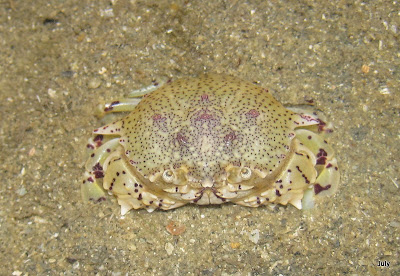120th Discovery Posting
Recently, an probably alarming amount of coral bleaching has been sighted and reported in Singapore and around the region. I will give a short list of blog posts with reference to some of these sightings at the end of this posting.
Coral Bleaching might not ring a bell for some discoverers/readers (my own friends included), so I have decided to dedicate a post on this issue.
First off, if you have ever been to the shores or watched shows that features corals, you might have noticed that corals are brownish/greenish in colour (picture below).
 However, it is important to note that the original colours of corals are not like that. Their original colour is more whitish or I could say white. Two main reasons for the colours would be coral fluoresence (a link will be provided at the end of this posting which will explain more about this) and the presence of zooxanthellae (a kind of algae) in the polyps of the corals.
However, it is important to note that the original colours of corals are not like that. Their original colour is more whitish or I could say white. Two main reasons for the colours would be coral fluoresence (a link will be provided at the end of this posting which will explain more about this) and the presence of zooxanthellae (a kind of algae) in the polyps of the corals.Now it is important to note that the zooxanthellae and corals share an important relationship. The corals provide a place or home for the zooxanthellae to stay in while the zooxanthellae will give the extra food it makes during photosynthesis to the coral. So basically, it's a "you scratch my back, I scratch your back" or "I help you, you help me" relationship.
So what is coral bleaching?
Well, first, it has nothing to do with bleach or dyeing... =P
Let me try to make it simple for everyone.
Imagine you are the zooxanthellae living in a polyp of a coral colony and these past few days, the water has been really hot and you cannot stand it (and there is NO fan or air-conditioning in the polyp). So what would you do?
Would you leave the polyp and get out in the open water to 'cool' down?
Yes, that's what happens, NOT the 'cool' down part though, I think...hahaha
So when you and many of your neighbours, the zooxanthellae leaves the coral, the coral will lose the brownish colours and show their original colour, white.
 Now here's another important point, you, the zooxanthellae, can provide up to 90% of the food that the coral needs. So what might happen if you and your neighbours leave the coral?
Now here's another important point, you, the zooxanthellae, can provide up to 90% of the food that the coral needs. So what might happen if you and your neighbours leave the coral?Yes, the corals might die!
 Another thing to note is that sometimes, after you and your neighbours (you are still a zooxanthellae) leave the coral. Other people, I mean zooxanthellae which can tolerate heat better might move into the coral.
Another thing to note is that sometimes, after you and your neighbours (you are still a zooxanthellae) leave the coral. Other people, I mean zooxanthellae which can tolerate heat better might move into the coral.Okay, even if you are not interested in corals and coral bleaching, here's something to make you sit up. One main reason that corals bleach is due to the increase of water temperature. The impact of this is not only the death of corals and the other organisms it supports. The increase of water temperature in our seas/oceans also means the ice caps will melt faster which leads to the increase of sea levels. Sitting up now? =D
Before I end, I would like to highlight that the increase of water temperature is NOT the only reason for coral bleaching to occur. There are other factors as well, I will leave some links for your own reading if you are interested to find out more and read more in depth about coral bleaching.
Here's a video from youtube that explains coral bleaching.
Here are the links that explain coral bleaching:
1) http://en.wikipedia.org/wiki/Coral_bleaching
2) http://www.marinebiology.org/coralbleaching.htm
3) http://saltaquarium.about.com/od/aboutcoraldiseases/a/aacoralbleach.htm
Here's the link that explains coral fluoresence
1) http://mountain-n-sea.blogspot.com/2007/12/coral-flourescence-and-other-attributes.html
Blog Links that report Coral Bleaching
1) Wildshores
2) http://tidechaser.blogspot.com/2010/05/extensive-coral-bleaching-at-semakau.html
3) http://wondercreation.blogspot.com/2010/06/snorkeling-at-tioman.html
 Despite the rainy weather, spirits were still quite high. I reckon this had to do with the amount of high energy the participants had. Hahaha... Anyway, the day got better as it went on. The first of it was a rainbow that appeared as we approached the forest trail.
Despite the rainy weather, spirits were still quite high. I reckon this had to do with the amount of high energy the participants had. Hahaha... Anyway, the day got better as it went on. The first of it was a rainbow that appeared as we approached the forest trail.





















